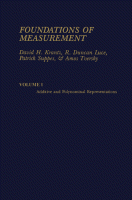Browse content
Table of contents
Actions for selected chapters
- Full text access
- Book chapterAbstract only
Chapter 1 - Introduction
Pages 1-37 - Book chapterAbstract only
Chapter 2 - Construction of Numerical Functions
Pages 38-70 - Book chapterAbstract only
Chapter 3 - Extensive Measurement
Pages 71-135 - Book chapterAbstract only
Chapter 4 - Difference Measurement
Pages 136-198 - Book chapterAbstract only
Chapter 5 - Probability Representations
Pages 199-244 - Book chapterAbstract only
Chapter 6 - Additive Conjoint Measurement
Pages 245-315 - Book chapterAbstract only
Chapter 7 - Polynomial Conjoint Measurement
Pages 316-368 - Book chapterAbstract only
Chapter 8 - Conditional Expected Utility
Pages 369-422 - Book chapterAbstract only
Chapter 9 - Measurement Inequalities
Pages 423-453 - Book chapterAbstract only
Chapter 10 - Dimensional Analysis and Numerical Laws
Pages 454-544 - Book chapterNo access
Answers and Hints to Selected Exercises
Pages 545-550 - Book chapterNo access
References
Pages 551-569 - Book chapterNo access
Author Index
Pages 571-575 - Book chapterNo access
Subject Index
Pages 577-584
About the book
Description
Additive and Polynomial Representations deals with major representation theorems in which the qualitative structure is reflected as some polynomial function of one or more numerical functions defined on the basic entities. Examples are additive expressions of a single measure (such as the probability of disjoint events being the sum of their probabilities), and additive expressions of two measures (such as the logarithm of momentum being the sum of log mass and log velocity terms). The book describes the three basic procedures of fundamental measurement as the mathematical pivot, as the utilization of constructive methods, and as a series of isomorphism theorems leading to consistent numerical solutions. The text also explains the counting of units in relation to an empirical relational structure which contains a concatenation operation. The book notes some special variants which arise in connection with relativity and thermodynamics. The text cites examples from physics and psychology for which additive conjoint measurement provides a possible method of fundamental measurement. The book will greatly benefit mathematicians, econometricians, and academicians in advanced mathematics or physics.
Additive and Polynomial Representations deals with major representation theorems in which the qualitative structure is reflected as some polynomial function of one or more numerical functions defined on the basic entities. Examples are additive expressions of a single measure (such as the probability of disjoint events being the sum of their probabilities), and additive expressions of two measures (such as the logarithm of momentum being the sum of log mass and log velocity terms). The book describes the three basic procedures of fundamental measurement as the mathematical pivot, as the utilization of constructive methods, and as a series of isomorphism theorems leading to consistent numerical solutions. The text also explains the counting of units in relation to an empirical relational structure which contains a concatenation operation. The book notes some special variants which arise in connection with relativity and thermodynamics. The text cites examples from physics and psychology for which additive conjoint measurement provides a possible method of fundamental measurement. The book will greatly benefit mathematicians, econometricians, and academicians in advanced mathematics or physics.
Details
ISBN
978-0-12-425401-5
Language
English
Published
1971
Copyright
Copyright © 1971 Elsevier Inc. All rights reserved.
Imprint
Academic Press
